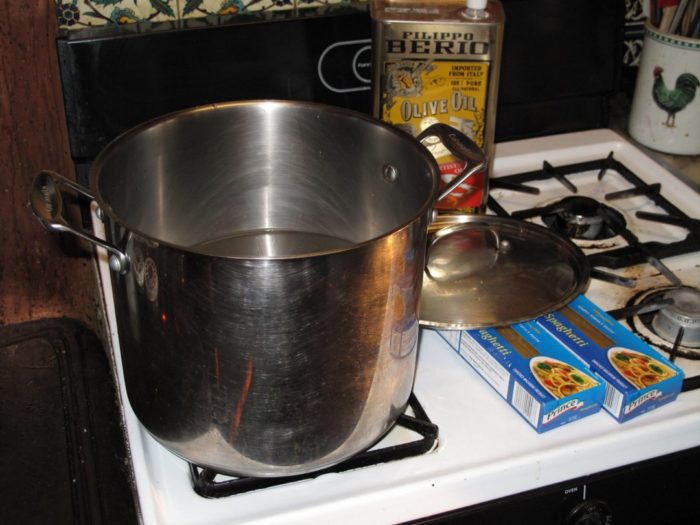
Image Credit: Martin Holladay
The traditional method for cooking pasta wastes energy, according to columnist Harold McGee. McGee, who writes the “Curious Cook” column for The New York Times, recently investigated whether 4 to 6 quarts of boiling water are really necessary to cook a single pound of pasta.
After experimenting in his kitchen and consulting with Italian chefs, McGee concluded that a pound of pasta can be cooked to perfection using a mere 1 1/2 to 2 quarts of water, as long as the cook stirs the pasta for the first 1 or 2 minutes of cooking.
Millions of dollars of wasted energy
“I’ve found that we can indeed make pasta in just a few cups of water and save a good deal of energy,” McGee reported. “Not that much in your kitchen or mine — just the amount needed to keep a burner on high for a few more minutes.”
McGee continued, “But Americans cook something like a billion pounds of pasta a year, so those minutes could add up. My rough figuring indicates an energy savings at the stove top of several trillion BTUs. At the power plant, that would mean saving 250,000 to 500,000 barrels of oil, or $10 million to $20 million at current prices.”
McGee’s article is posted at The New York Times Web site.
Weekly Newsletter
Get building science and energy efficiency advice, plus special offers, in your inbox.














5 Comments
Rethinking Cooking procedures
Martin & Harold,
This is more than just the matter of the energy wasted to cook the pasta....
There is also an energy penalty associated with removing the extra moisture from the living space.
Many times Modern energy efficient homes have a surplus of moisture that needs to be eliminated either by extra(sometimes costly) air changes, extra air conditioning or supplemental dehumidification.
Gentlemen,
While the savings
Gentlemen,
While the savings in BTU's required to heat the excess water is dramatic, and the energy required to remove the additional interior moisture will add up,how about the energy savings in pumping and distributing the reduced amount of required water for the pasta cooking process? In addition to all this energy savings, how much water savings are we talking about? Using the numbers provided and if my math is right, we're talking about one billion gallons of water! Not just in drought prone areas like Colorado where we average seventeen inches of rain annually, thats an impressive reduction in water consumption. How many other examples of this kind of water and energy savings are out there waiting to be identified? AS we all know, the long road to energy independence starts with conservation.
More info on energy-efficient cooking
More information on energy-efficient cooking can be found in a March 18, 2009 Boston Globe article titled, "En route to greener life? You'll need a map." The article notes, "Ulf Sonesson, research coordinator for environmental research at the Swedish Institute for Food and Biotechnology, has looked at the most energy-efficient way of cooking. While scenarios can vary, a rough rule of thumb is: The microwave uses the least energy, followed by frying and boiling and, finally, the conventional oven. (Think how wasteful it is to heat up an entire oven just to cook a baked potato or two.) And since it's more energy-efficient to cook lots of food at once, Sonesson adds: 'Eat with a friend. That saves a lot of energy, actually.'"
These are non-cooks
Sorry, guys, but non-cooks who grew up eating Chef Boy-Ar-Dee mush apparently have no sense of the taste and texture of perfectly prepared pasta. Unless you plan to stand and stir the entire time your pasta cooks, you won't enjoy the full extent of Italian food. Without adequate room for pasta to roam, it cooks unevenly. You probably make up for that by cooking it longer, which breaks down the texture, a major component of taste, giving you the Chef Boy-Ar-Dee effect.
Response to Susan Wohlford
Susan,
I agree with one of your points: if the end result is overcooked pasta, then the energy savings aren't worth it.
Many cooks wouldn't consider it particularly burdensome to stir the pasta for 6 to 11 minutes. At the same time, you'll probably be standing at the stove anyway, stirring your sauce. Anyway, you can't ever really walk away from a pot of cooking pasta, because you have to taste it every 30 seconds to determine when it is al dente. Since you are standing there anyway, why not stir?
Remember, too, that the shape and size of the pasta will determine whether cooking is even or uneven. While failure to stir may result in uneven cooking with some pasta shapes, the same cooking method might work well with other pasta shapes.
Here's the bottom line: don't be timid with experimentation in the kitchen. Try cooking with less pasta water, and see if you like the results.
Of course, we all agree -- just say no to overcooked pasta!
Log in or create an account to post a comment.
Sign up Log in